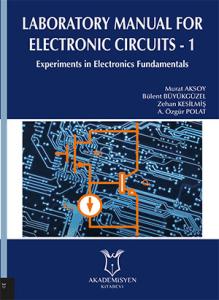Laboratory Manual for Electronic Circuits - 1
Özet
This laboratory guide has been prepared for students taking the EEE226 Electronic Circuits course at Çukurova University, Department of Electrical and Electronics Engineering. The content covers the course materials taught in the department. The main purpose of the guide is to verify the theory taught in electronic courses in the laboratory.This guide is divided into two sections. Section 1 introduces laboratory rules, simulation of electronic circuits, and the equipment (Oscilloscope, DC Power Supply, DMM, and Signal Generator) used in laboratory experiments. Section 2 is dedicated to experiments involving basic electronic circuits taught in EEE226. It consists of nine experiments, starting with basic measurements and learning the equipment used in the Electronic Laboratory. The following three experiments focus on diode characteristics and circuits. The next four experiments focus on transistor characteristics and basic BJT and FET transistor-based amplifiers. The final experiment focuses on the frequency response of basic amplifiers.Each experiment includes the following sections:Objective: States the objective of the experiment.Theory: Provides complementary information about the theory related to the experiment.Preparation: Detailed analysis of the experiment and the section that needs to be completed before coming to the laboratory.Experiment Procedure: Includes structured steps for conducting the experiment.Results: This section is included to evaluate the differences between theoretical and experimental results.Equipment List: Lists components and standard equipment such as DMM, Oscilloscope, signal generator, and prototype board.Attachments include datasheets of components used in the experiments.This guide aims to assist students in applying their theoretical knowledge in electronic circuits courses in the laboratory.

Yayınlanan
Lisans
LisansBu İnternet Sitesi içeriğinde yer alan tüm eserler (yazı, resim, görüntü, fotoğraf, video, müzik vb.) Akademisyen Kitabevine ait olup, 5846 sayılı Fikir ve Sanat Eserleri Kanunu ve 5237 sayılı Türk Ceca Kanunu kapsamında korunmaktadır. Bu hakları ihlal eden kişiler, 5846 sayılı Fikir ve Sanat eserleri Kanunu ve 5237 sayılı Türk Ceza Kanununda yer alan hukuki ve cezai yaptırımlara tabi olurlar. Yayınevi ilgili yasal yollara başvurma hakkına sahiptir.
